York, North Yorkshire, England
A view towards York Minster
Treasurer's House
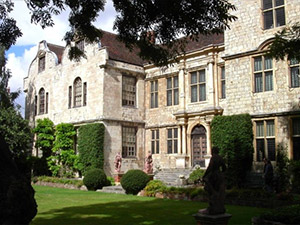
The first Treasurer for York Minster was appointed in 1091, but all that remains of his original house is an external wall. However, since that time the Treasurer's occupied the site until 1539, when it passed into private ownership. It was significantly rebuilt during the 17th century. The Treasurer's House is owned by the National Trust.
In 1953, a young plumbing apprentice named Harry Martindale, had what has become a classic encounter in the annals of ghost sightings. Whilst he was working in the cellar he became aware of the sound of a distant trumpet which was then followed by another. What he saw next, was a complete shock.
A horse's head came through the cellar wall, followed by its body on which rode a Roman soldier. It proceeded to walk across his path and through the opposite wall. The rider was followed by a troop of Roman soldiers walking behind. He noted that all of the passing troop were cut off at the knee, as if they were walking through the floor level.
Harry Martindale was not the only person to observe the Romans. Later excavation revealed a Roman Road at the spot which was approximately 12 inches beneath the floor level.
Pictured left is the Treasurer's House courtesy of Tom Pennington.
Minster Yard,
York,
North Yorkshire,
YO1 7JL.
For further information, please read Haunted Britain and Ireland by Richard Jones and Ghosts: Mysterious Tales from the National Trust by Sian Evans.
The Shambles
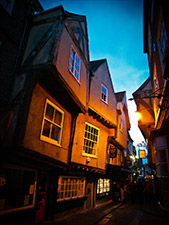
The Shambles (official name Shambles) is an old street, with overhanging timber-framed buildings, some dating back as far as the fourteenth century. It is a wonderfully atmospheric place to visit, day or night. It has a number of ghostly tales associated with it.
Brooks recounts an unusual story that took place sometime during the early 1960's. The tale concerns two old farming gentleman who were visiting York, and foound themselves in The Shambles. As they took cover from the rain, an elderly lady invited them into one of the houses. She insisted the men rest, get dry and have some food with her. Although the food was not to their liking, they appreciated her kindness and decided to return with a gift on their next visit. However, when they returned, they could not find the house or woman!
Another tale concerns one Margaret Clitheroe who lived on The Shambles during the reign of Elizabeth I. Clitheroe was a staunch and ferverently vocal Catholic. Despite warnings and arrests, she was finally convicted of treason and sentenced to death by pressing. Some have suggested her ghost lingers here.
Pictured above is The Shambles courtesy of Sebastian Mrozek.
Coordinates:
53°57′33.85″N 1°4′48.40″W.
For further information, please read Britain's Haunted Heritage by J A Brooks.
The Theatre Royal
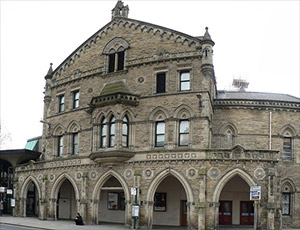
York Theatre Royal was built in 1744 on, and among, the site of the medieval St. Leonard's Hospital.
Parts of the old hospital can still be seen in the modern building, including archways and walls.
The theatre has been designated a Grade II* listed building by English Heritage.
The Theatre Royal is home to the Grey Lady, who according to a medium was a Nun from when a convent stood on the site.
Pictured left is The Theatre Royal.
York Theatre Royal,
St. Leonard’s Place,
York,
YO1 7HD.
For further information, please read Britain's Haunted Heritage by J A Brooks.
Trinity Church, Micklegate
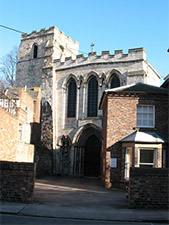
Trinity Church, or more commonly referred to as Holy Trinity Church, lies at the historic quarter and is in the building constructed for Micklegate Priory, a Benedictine foundation under Marmoutier Abbey.
The church dates from the 12th century with additions in the 13th and 14th centuries. The tower dates from 1453. The church was remodelled after the Dissolution of the Monasteries. It is listed in the Domesday Book of 1086 as one of five great northern churches (alongside, amongst others, York Minster).
The church has been designated a Grade I* listed building by English Heritage.
According to Coxe, the church is haunted by three ghosts, all of whom are from the same family.
Pictured left is Holy Trinity Church, seen here from Priory Street, courtesy of Gordon Hatton.
Holy Trinity Church,
83 Micklegate,
York,
YO1 6LE.
For further information, please read Haunted Britain by Antony D. Hippisley Coxe.
York Castle

The now-ruinous keep of the medieval Norman castle is commonly known as Clifford's Tower. Originally constructed on the orders of William I, the castle suffered a turbulent early history before developing into a major fortification with extensive water defences. However, in 1684, an explosion rendered the remaining military defences uninhabitable. York Castle continued to be used as a jail and prison until 1929.
The castle is classed as a Grade I listed building and a Scheduled monument. The site, managed by English Heritage, is open to the public.
In 1190, York Castle was the location of one of the worst pogroms (anti-Jewish violence) in England during the medieval period. Following a violent mob altercation, Josce of York, the leader of the Jewish community, led the local Jewish families into the royal castle, where they took refuge in what was then a wooden keep. A mob surrounded the castle and a siege ensued until 16th March. By this time, their position became untenable. Their religious leader proposed an act of collective suicide to avoid being killed by the mob, and the castle was set on fire to prevent their bodies being mutilated after their deaths. Several Jews perished in the flames but the majority took their own lives rather than give themselves up to the mob. A few Jews did surrender, promising to convert to Christianity, but they were killed by the angry crowd. In total, approximately 150 Jews died in the massacre. It is claimed that this horrific event has etched itself into the very fabric of the castle, causing the walls to change to the colour of blood on occasions.
According to Coxe, in 1717 the unusual apparition was reported. Initially it appeared as a piece of paper blowing in the wind, but changed form into a monkey and then a bear.
Pictured left is York Castle from our visit in December 2017.
Tower Street,
York,
North Yorkshire,
YO1 9SA.
For further information, please read Haunted Britain by Antony D. Hippisley Coxe.
York Minster
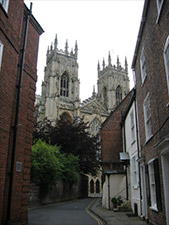
York Minster is the cathedral of York, and is the seat of the Archbishop of York. The first recorded church on the site was a wooden structure built in 627, whereas the first stone building was built in the 630's.
However, the magnificent building we see today has parts dating from 1220.
During World War One, two young women were working in the Minster one evening, when they both saw a soldier walking towards them. As he drew closer, he simply melted away. The soldier was recognised as the brother of one of the two women. The sister knew at that moment that her brother was dead.
Before heading to France, the young man had promised his sister that he would come back to her if he was killed. Some time later, she discovered that he was drowned when the ship he was travelling on sank.
Pictured left is the York Minster courtesy of Dudesleeper.
York Minster,
Deangate,
York,
YO1 7HH.
For further information, please read Britain's Haunted Heritage by J A Brooks.
















